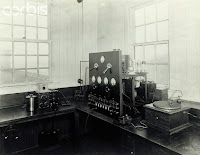In 1920, Dr. Frank Conrad was an engineer in the employ of the Westinghouse Electric Company. He was also an amateur radio operator. With the release by Congress in July 1919 of all privately held radio and telephone equipment now that World War I had ended, the race to commercialize the new science of radio telephony was on.

To test transmissions during the war, Conrad placed one transmitter and receiver at the Westinghouse plant and another above his garage at home, four miles away. When the war ended and the government lifted the restrictions on amateur radio telephony, Conrad went back to his experimentation from home.
After the war, a fierce battle ensued between the US government and the Department of the Navy over control of the airwaves. The government won out and settled on the Department of Commerce to run things, wresting control from the Navy's hands. After the dust cleared, in April 1920, Conrad applied to the Department of Commerce to license his station. He was given the call letters 8XK.

Westinghouse saw that Conrad's experiments might be important and potentially profitable, and so with Conrad's help, started construction of a new transmitting facility on the roof of the Westinghouse plant in East Pittsburgh, PA. A presidential election campaign was in full progress that year, the election of 1920. The Republican ticket, comprised of Senator Warren G. Harding of Ohio and Governor Calvin Coolidge of Massachusetts was paired against the Democratic ticket's Governor James Cox of Ohio and former under secretary of the navy Franklin Delano Roosevelt.
On October 27, 1920, Westinghouse's radio facility was completed, and the Department of Commerce granted it the historic call sign KDKA. It transmitted on a frequency of 833 KHz (360 meters) with a power of 100 watts. Only two frequencies were assigned for broadcasting at this time. The other was 619 KHz (485 meters).
Hastily constructed, the "radio facility" was hardly more than a simple metal shack with all the necessary wires and equipment, and a desk from which an announcer could report election results. The election was slated for November 2.
On Tuesday, November 2, 1920, election night, up in that metal shack four men in dark suits compiled election returns received via wired-telephone from the newsroom at the Pittsburgh Post. The results were handed to one Leo H. Rosenburg. Leaning forward into an early microphone, Rosenburg's voice was sent through wires and apparatus out into the ether. It is estimated that between 500 and 1000 listeners heard this broadcast.
The excitement triggered by KDKA's 1920 election coverage set off a national hysteria for radio. Within weeks, Conrad had upped KDKA's power to 500 watts. It was now being heard as far away as Washington, D.C. Conrad started adding entertainment programs according to a schedule. Radio broadcasting, as we know it, was born.
Happy birthday KDKA-1020, Pittsburgh, PA, now 50,000 watts!
The Aeriola Senior regenerative radio.
Introduced December, 1921. $65.00
Introduced December, 1921. $65.00






No comments:
Post a Comment